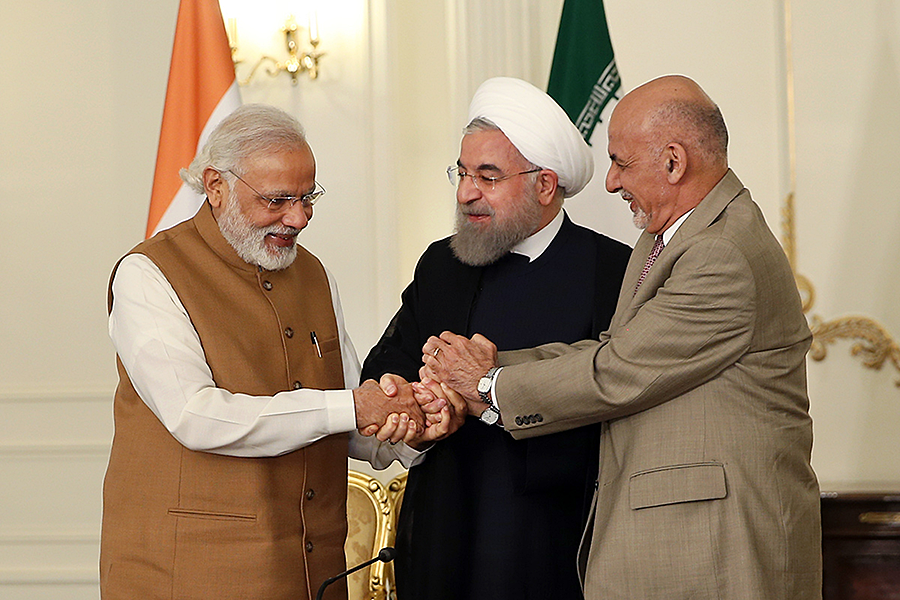How significant is India's $500 million deal with Iran?
Loading...
India pledged Monday to contribute up to $500 million to the development of a port at Chabahar in southern Iran, part of a three-nation agreement that also includes Afghanistan.
The deal represents a victory for India, which has long sought access to the markets of Iran, Afghanistan, and Central Asia, but has been unable to overcome its thorny relationship with neighboring Pakistan to easily realize that dream.
But other geopolitical forces are also at play, not least with respect to what the agreement says about the deepening, maturing relationship between India and the United States – and Indian efforts to keep Chinese dominance at bay.
“This is highly significant for India, especially if they follow up and seize upon these opportunities,” says Sumit Ganguly, senior fellow for the Asia program at the Foreign Policy Research Institute, in a telephone interview with The Christian Science Monitor.
“Otherwise this whole agreement will amount to a hill of beans,” he says.
India’s investment of $500 million in the port itself is to be accompanied by a further $16 billion for a “Chabahar free trade zone,” which will incorporate rail links heading north into Afghanistan.
But India's additional investment pales in comparison to China’s pledge of $46 billion to develop the Pakistani port of Gwadar, not even 125 miles from Chabahar, along with an accompanying network of railways, pipelines, and roads to connect with western China.
Infrastructure projects of any kind in this part of the world represent “a Herculean task”, as Rick Rossow, Wadhwani Chair in U.S.-India Policy Studies at the Center for Strategic and International Studies, explains to the Monitor in a phone interview.
Yet analysts detect determination in India’s current administration, with Mr. Rossow describing a “committed leadership” and Dr. Ganguly, who is also director of Indiana University’s Center on American and Global Security, praising Indian Prime Minister Narendra Modi’s “multi-dimensional foreign policy.”
This particular project is nothing new, first floated by India in 2003. It has become possible now because of warming relations between the United States and Tehran, specifically the nuclear agreement and the subsequent lifting of sanctions against the Islamic Republic.
There was some skepticism in Washington on Tuesday, when senators quizzed a State Department official about the remaining sanctions and whether they might be violated by the development of Chabahar, but aside from the reassurances provided, there is another factor to be considered here: As President Barack Obama himself has said, the relationship between India and the United States is “one of the defining partnerships of the 21st century.”
“The US has tried to steer India away from deepening ties with Iran,” says Mr. Rossow. “But India and the US share a strong and growing strategic interest, which means they can do some things that are in the interest of one and not the other, without risking the relationship: it’s deep enough to withstand that.”
One of the reasons for the depth of that relationship is another rising power, China. But while this new port may give a certain degree of relief to India, and indeed allow Iran to loosen somewhat its own relationship with China, analysts expect the Chinese themselves to pay little heed – at least for now.
The Pakistanis, on the other hand, may be less sanguine. With such a militarized leadership, they may begin to feel encircled, viewing as a potential security threat this onslaught of friendship among three of their neighbors. In response, observers say, they may seek to bolster ties with the fourth and final country with whom they share a border: China.
For Afghanistan, apart from the tangible economic benefits it could bring, the project also speaks to India’s faith in that country’s future – a sentiment not shared by everyone, as Afghanistan struggles to find a constructive way forward.
Finally, as Rossow highlights, there is a relationship that may see less coverage, but could also be impacted – that between India and Israel.
“India is one of the few players that has managed to balance relationships with Middle East countries,” says Rossow. “They can visit Tehran, as well as Israel, being welcomed in both.”
With relations between Israel and Iran not experiencing quite the thaw that is gracing those between Tehran and Washington, Israel may be less impressed by India’s overtures toward the Islamic Republic.
Yet the Jewish state may also be forgiving, understanding of India’s economic needs. And certainly the relationship with Iran will be of more immediate concern in the minds of those taking policy decisions in New Delhi.
“India and Iran also share a crucial stake in peace, stability and prosperity of the region,” said Prime Minister Modi, during his visit to Iran. “We also have shared concerns at the spread of forces of instability, radicalism, and terror in our region.”








